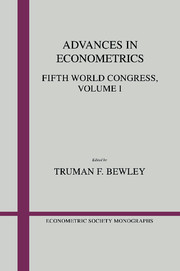Book contents
- Frontmatter
- 1 Specification testing in dynamic models
- 2 Specification tests: an overview
- 3 Kernel estimators of regression functions
- 4 Identification and consistency in semi-nonparametric regression
- 5 On econometric models with rational expectations
- 6 Calculating asset prices in three example economies
- 7 The Kalman filter: applications to forecasting and rational-expectations models
- 8 Applications of the Kalman filter in econometrics
4 - Identification and consistency in semi-nonparametric regression
Published online by Cambridge University Press: 05 January 2013
- Frontmatter
- 1 Specification testing in dynamic models
- 2 Specification tests: an overview
- 3 Kernel estimators of regression functions
- 4 Identification and consistency in semi-nonparametric regression
- 5 On econometric models with rational expectations
- 6 Calculating asset prices in three example economies
- 7 The Kalman filter: applications to forecasting and rational-expectations models
- 8 Applications of the Kalman filter in econometrics
Summary
Nonlinear least squares is the prototypical problem for establishing the consistency of nonlinear econometric estimators in the sense that the analysis abstracts easily and the abstraction covers the standard methods of estimation in econometrics: instrumental variables, two- and three-stage least squares, full information maximum likelihood, seemingly unrelated regression, M-estimators, scale-invariant M-estimators, generalized method of moments, and so on (Burguete, Gallant, and Souza 1982; Gallant and White 1986). In this chapter, nonlinear least squares is adapted to a function space setting where the estimator is regarded as a point in a function space rather than a point in a finite-dimensional, Euclidean space. Questions of identification and consistency are analyzed in this setting. Least squares retains its prototypical status: The analysis transfers directly to both the above listed methods of inference on a function space and to semi-nonparametric estimation methods. Two semi-nonparametric examples, the Fourier consumer demand system (Gallant 1981) and semi-nonparametric maximum likelihood applied to nonlinear regression with sample selection (Gallant and Nychka 1987), are used to illustrate the ideas.
Introduction
The intent of a semi-nonparametric methodology is to endow parametric inference with the nonparametric property of asymptotic validity against any true state of nature. The idea is to set forth a sequence of finite dimensional, parametric models that can approximate any true state of nature in the limit with respect to an appropriately chosen norm. As sample size increases, one progresses along this sequence of models. The method is parametric.
- Type
- Chapter
- Information
- Advances in EconometricsFifth World Congress, pp. 145 - 170Publisher: Cambridge University PressPrint publication year: 1987
- 17
- Cited by



